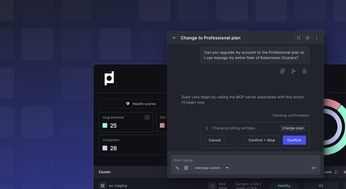
Kubernetes Persistent Volumes: The Ultimate Guide
Learn how to manage Kubernetes persistent volumes effectively, covering provisioning, best practices, and troubleshooting to ensure data persistence and reliability.
Stateful apps in Kubernetes need persistent storage. Kubernetes Persistent Volumes (PVs) handle this, keeping your data safe even if pods are terminated. This guide covers using PVs, from the basics to advanced management. We'll explore how PVs work, different PV types, and best practices for performance and security. Whether it's a small database or a large data pipeline, understanding Kubernetes Persistent Volumes is key for reliable stateful applications.
This post serves as a comprehensive guide to understanding and utilizing Kubernetes persistent volumes effectively. We'll cover the fundamental concepts, explore different storage types and provisioning methods, and delve into best practices for managing and optimizing your persistent storage. We'll also explore how Kubernetes PVs enable you to decouple storage from your application's lifecycle, ensuring data availability and integrity even in the face of pod failures or rescheduling.
Unified Cloud Orchestration for Kubernetes
Manage Kubernetes at scale through a single, enterprise-ready platform.
Key Takeaways
- PVs decouple storage management from application configuration: Define the storage your application needs without worrying about the underlying infrastructure. Kubernetes handles the details.
- PVCs simplify storage requests: Specify the type and amount of storage required; Kubernetes automatically provisions and connects the appropriate PV.
- Proactive management ensures reliable persistent storage: Plan for capacity, monitor performance, and implement security best practices to keep your data safe and your applications running smoothly.
What is a Kubernetes Persistent Volume (PV)?
A Persistent Volume (PV) represents a piece of storage in your Kubernetes cluster. Think of it as a dedicated hard drive available for your applications. Unlike ephemeral storage that disappears when a pod is terminated, data stored on a PV persists even if the pod using it is deleted or rescheduled. This makes PVs essential for stateful applications like databases, message queues, and other services that require persistent data.
PVs are provisioned by an administrator or dynamically created using Storage Classes. This separation of storage provisioning from application deployment allows for greater flexibility and control over your storage resources. Using Plural, you can simplify the management of PVs across your entire Kubernetes fleet.
The PV Lifecycle: Provisioning, Binding, Using, and Reclaiming
PVs follow a distinct lifecycle consisting of four key stages: provisioning, binding, using, and reclaiming. Understanding this lifecycle is crucial for managing your persistent storage effectively.
During provisioning, the PV is created and made available to the cluster. Binding occurs when a Persistent Volume Claim (PVC) requests storage. Kubernetes then matches the PVC with a suitable PV and links them together. The using stage begins when a pod is granted access to the bound PV, allowing it to read and write data. Finally, reclaiming happens when the PVC is deleted. The PV's reclaim policy determines what happens to the underlying storage.
Reclaim Policies: Retain, Delete, and Recycle (Deprecated)
The reclaim policy dictates how Kubernetes handles the storage associated with a PV after it's released. There are three options: Retain, Delete, and Recycle (now deprecated). The Retain policy keeps the data on the PV, allowing you to manually reclaim it later. Delete removes the PV and the associated storage. The deprecated Recycle option attempted to clean up the PV for reuse, but it's no longer recommended due to potential data security issues. Dynamic provisioning with Storage Classes offers a more robust and secure approach.
Key Features of a PV
Access Modes: ReadWriteOnce, ReadOnlyMany, and ReadWriteMany
Access modes control how applications can access the storage provided by a PV. ReadWriteOnce (RWO) allows a single node to access the volume with read-write permissions. ReadOnlyMany (ROX) enables multiple nodes to access the volume in read-only mode. ReadWriteMany (RWX) allows multiple nodes to access the volume with read-write permissions. Choosing the right access mode depends on the specific requirements of your application. For example, a database typically requires RWO, while a shared data source for web servers might use ROX or RWX.
Persistent Volume Types
Kubernetes supports a variety of persistent volume types, including NFS, iSCSI, local storage, and cloud provider-specific options like AWS EBS and Google Persistent Disk. Additionally, the Container Storage Interface (CSI) allows for seamless integration with third-party storage providers, expanding the range of storage options available within your Kubernetes cluster. This flexibility allows you to choose the storage solution that best fits your needs and budget.
How to Create a Persistent Volume
Creating a PV involves defining its specifications in a YAML file and then applying it to the cluster using kubectl apply -f <pv-definition.yaml>. The YAML file should include details like the storage capacity, access mode, and the specific storage type being used. See the Kubernetes documentation for detailed examples.
What is a Kubernetes Persistent Volume Claim (PVC)?
A Persistent Volume Claim (PVC) is essentially a request for storage by an application. It's like your application submitting an order for a specific type and amount of storage. The PVC doesn't directly interact with the underlying storage infrastructure; instead, it relies on Kubernetes to find a suitable Persistent Volume (PV) to fulfill the request.
Understanding PVCs
PVCs simplify storage management for developers. They allow applications to request storage without needing to know the intricate details of the underlying storage provider. This abstraction simplifies deployment and makes applications more portable across different Kubernetes environments. With Plural, managing PVCs and their associated PVs becomes even easier, especially across large, multi-cluster deployments.
How PVCs Work
When a PVC is created, Kubernetes searches for an available PV that matches the requested specifications, such as storage capacity and access mode. Once a suitable PV is found, Kubernetes binds the PVC to the PV, making the storage accessible to the requesting application. This dynamic binding process ensures efficient utilization of storage resources.
The Relationship Between PVCs and PVs (Analogies)
A common analogy to understand the relationship between PVCs and PVs is to think of ordering a coffee. The PVC is like ordering a "large latte" (storage request). The barista then finds a large cup (the PV) and fills it with the latte. Kubernetes acts as the barista, taking the order (PVC) and finding the appropriate resources (PV) to fulfill it.
How to Create a Persistent Volume Claim
Similar to creating a PV, a PVC is defined in a YAML file and applied to the cluster using kubectl apply -f <pvc-definition.yaml>. The YAML file specifies the desired storage size, access modes, and any other relevant parameters. Refer to the Kubernetes documentation for comprehensive examples and further details.
Data Sources for PVCs: Using Existing PVCs and Snapshots
PVCs can also be created from existing PVCs or snapshots, enabling efficient data cloning and restoration. This is particularly useful for tasks like creating backups, restoring from backups, or setting up test environments. The dataSource or dataSourceRef fields in the PVC YAML definition allow you to specify the source for the new PVC. This streamlines data management and allows for rapid provisioning of new environments based on existing data.
Understanding Kubernetes Persistent Volumes
Persistent Volumes (PVs) are fundamental Kubernetes resources that abstract physical storage details from how applications consume that storage. They act as a layer of indirection: your application requests storage with certain characteristics, and a PV fulfills that request. Your application doesn't need to know the underlying infrastructure specifics. This abstraction simplifies deployment and management, especially across different environments. A PV represents a piece of storage in the cluster, pre-provisioned by an administrator or dynamically provisioned on demand. Critically, it exists independently of any individual pod. The data persists even if the pod using it restarts or fails. This characteristic makes PVs essential for running stateful applications in Kubernetes.
apiVersion: v1
kind: PersistentVolume
metadata:
name: example-pv
spec:
capacity:
storage: 1Gi
accessModes:
- ReadWriteOnce
persistentVolumeReclaimPolicy: Retain
hostPath:
path: "/mnt/data"Benefits of Kubernetes Persistent Storage
PVs offer several key advantages:
- Durability: Data in a PV outlives the pods that use it, ensuring data persistence across application restarts and failures. This is crucial for stateful applications like databases.
- Abstraction: PVs decouple storage implementation details from application configuration. Developers define the storage requirements without needing to know the specifics of the underlying storage provider.
- Flexibility: Kubernetes supports various PV types, from cloud-provider specific solutions like AWS EBS and Azure Disk to more general network-attached storage like NFS and iSCSI. This allows you to choose the best storage option for your workload.
- Portability: By abstracting storage details, PVs make it easier to move applications between different Kubernetes clusters, even across different cloud providers or on-premises environments.
Kubernetes Storage: Persistent vs. Ephemeral
The key distinction between persistent and ephemeral storage lies in data lifecycle management. Ephemeral storage, typically used for stateless applications, is tightly coupled to the pod's lifecycle. If the pod terminates, the associated storage is also deleted. This behavior works for applications that don't require persistent data, such as web servers serving static content.
However, for applications like databases, message queues, or other stateful services, data persistence is paramount. This is where PVs become essential. By providing storage that exists independently of pods, PVs ensure data survives pod restarts and failures, guaranteeing the integrity and availability of stateful applications. In large-scale deployments, managing data persistence is even more critical. Losing data due to container or pod failures can have significant consequences. PVs address this by providing a reliable mechanism for storing and managing persistent data in Kubernetes.
Working with Kubernetes Persistent Volume Claims (PVCs)
A PersistentVolumeClaim (PVC) is a user's request for storage within a Kubernetes cluster. Similar to a Pod requesting CPU and memory, a PVC specifies the storage needs of an application. This abstraction lets developers focus on how much storage they need, not where it comes from. A PVC describes the desired size, access modes (e.g., ReadWriteOnce, ReadWriteMany), and storage class, allowing Kubernetes to handle the underlying provisioning.
apiVersion: v1
kind: PersistentVolumeClaim
metadata:
name: example-pvc
spec:
accessModes:
- ReadWriteOnce
resources:
requests:
storage: 500MiHow PVCs and Persistent Volumes Interact
Persistent Volumes (PVs) and Persistent Volume Claims (PVCs) are the core components of Kubernetes persistent storage. A PV represents a piece of storage in the cluster, while a PVC is a request to use that storage. Kubernetes automatically binds a PVC to a suitable PV. This decoupling simplifies storage management—users interact with PVCs, and Kubernetes handles the complexity of connecting them to PVs. This dynamic makes persistent storage management flexible and efficient, abstracting away the underlying storage infrastructure.
PVC Binding and Lifecycle Management
PVCs have a simple lifecycle. They begin in a Pending state while waiting for a matching PV. When Kubernetes finds a suitable PV, it binds the PVC, changing its state to Bound. This one-to-one binding ensures dedicated storage for the PVC. The lifecycle of a PV is more complex, encompassing provisioning, binding, using, and reclaiming. Understanding these stages is crucial for managing persistent storage. The "reclaim" stage determines what happens to the storage after the PVC is deleted: deletion, recycling, or retention for later use. We'll cover PV lifecycle management in more detail later in this post.
Choosing the Right Kubernetes Persistent Volume Type
Persistent Volumes (PVs) in Kubernetes offer various ways to store data, each with its own strengths and weaknesses. Choosing the right PV type depends on factors like your application's needs, your infrastructure, and performance requirements.
Exploring Network-Based Persistent Storage
Network-based storage solutions offer flexibility and accessibility across your cluster. One common example is Network File System (NFS), a widely used protocol that allows multiple pods to access the same storage volume concurrently. This makes NFS suitable for applications requiring shared file access, like content management systems or collaborative workspaces. Another option is iSCSI, which uses block-level access for better performance with applications needing raw block storage, such as databases.
apiVersion: v1
kind: PersistentVolume
metadata:
name: nfs-pv
spec:
capacity:
storage: 2Gi
accessModes:
- ReadWriteMany # Multiple Pods can mount
persistentVolumeReclaimPolicy: Retain
nfs:
path: /exported/path
server: 192.168.1.100Cloud Provider Solutions for Persistent Storage
Cloud providers offer integrated storage solutions that work seamlessly with Kubernetes. The Container Storage Interface (CSI) is the recommended way to connect to these services. CSI provides a standard interface for Kubernetes to interact with various storage providers, simplifying management and deployment.
For example, if you're running on AWS, you can use a CSI driver to connect to Elastic Block Store (EBS). Similarly, Azure offers Azure Disk, and Google Cloud Platform (GCP) provides Persistent Disk, all accessible via CSI. These cloud-specific solutions offer advantages like scalability, snapshots, and backups integrated with the cloud provider's ecosystem.
apiVersion: v1
kind: PersistentVolume
metadata:
name: aws-ebs-pv
spec:
capacity:
storage: 10Gi
accessModes:
- ReadWriteOnce # Single-node access
persistentVolumeReclaimPolicy: Retain
awsElasticBlockStore:
volumeID: vol-0abcd1234efgh5678
fsType: ext4Using Plural to Manage Cloud Provider Storage
Managing Persistent Volumes (PVs) across a large Kubernetes estate can quickly become complex. Cloud provider storage solutions like AWS EBS, Azure Disk, or GCP Persistent Disk offer scalability and integration, but managing these resources across multiple clusters requires careful orchestration. Plural simplifies this process.
With Plural, you leverage Infrastructure-as-Code (IaC) to define and manage your cloud provider storage. Using Plural Stacks, you define your storage requirements in Terraform, Ansible, or Pulumi, declaratively provisioning and managing PVs alongside the rest of your infrastructure. Plural ensures consistent provisioning and configuration across your clusters, reducing the risk of configuration drift and simplifying management.
For example, define an AWS EBS volume in your Terraform configuration, specifying the size, type, and availability zone. Plural uses this configuration to provision the EBS volume and create the corresponding PV and Persistent Volume Claim (PVC) resources in your Kubernetes clusters. This automation streamlines everything from initial provisioning to ongoing management.
Plural's GitOps-driven approach ensures your storage configuration is version-controlled and auditable. Changes to your IaC code are automatically deployed, maintaining consistency and simplifying rollbacks. This gives you a centralized view of your storage infrastructure, making it easier to manage and troubleshoot.
Leveraging Local Storage in Kubernetes
Local storage, represented by the hostPath PV type uses storage directly on the node where a pod runs. This can offer excellent performance for applications needing low-latency access to data. However, hostPath volumes are generally unsuitable for production workloads. If the node fails, the data becomes unavailable, and rescheduling the pod to another node won't bring the data with it. Therefore, hostPath is primarily used for development, testing, and specialized scenarios where data locality is paramount and data loss is acceptable. For production, network-based or cloud-provider solutions are preferred for their resilience and data persistence.
apiVersion: v1
kind: PersistentVolume
metadata:
name: local-pv
spec:
capacity:
storage: 1Gi
accessModes:
- ReadWriteOnce # Single-node access
persistentVolumeReclaimPolicy: Retain
hostPath:
path: "/mnt/data"Managing the Kubernetes Persistent Volume Lifecycle
This section covers the lifecycle stages of a Kubernetes Persistent Volume (PV), from creation to termination, and the options available for managing your storage resources.
Static vs. Dynamic Provisioning for Persistent Volumes
There are two main ways to provision Persistent Volumes: statically and dynamically. With static provisioning, a cluster administrator manually creates a PV. This involves defining the storage characteristics, such as size, access mode, and reclaim policy, and making it available in the cluster. Think of this as pre-allocating storage. Dynamic provisioning automates PV creation based on the requirements specified in a PVC. When a PVC is created, the system automatically provisions a matching PV if a suitable StorageClass exists. Dynamic provisioning simplifies storage management and is generally preferred over static provisioning.
Binding, Using, and Reclaiming Persistent Volumes
A PV goes through several stages during its lifecycle. First, it's provisioned, either statically or dynamically. Next, a PVC requests the PV, and if the PV's characteristics match the PVC's requirements, they are bound together. Once bound, a Pod can use the PV for storage. Finally, when the PVC is deleted, the PV enters the reclaiming phase. The reclaim policy, set during PV creation, determines what happens to the underlying storage. The storage can be deleted, retained for later use, or recycled (if supported by the underlying storage system).
Access Modes and Reclaim Policies for Persistent Storage
Access modes define how a PV can be accessed by Pods. ReadWriteOnce allows a single node to read and write to the volume. ReadOnlyMany allows multiple nodes to read from the volume. ReadWriteMany allows multiple nodes to read and write to the volume. And ReadWriteOncePod allows a single pod to read and write to the volume. Choosing the right access mode depends on the application's requirements and the capabilities of the underlying storage system. The reclaim policy determines what happens to the storage when the PV is no longer needed. The available reclaim policies are Retain, Recycle, and Delete.
Dynamic Provisioning with Kubernetes Storage Classes
PVs and PVCs abstract the underlying storage implementation from your application. Storage Classes take this abstraction a step further, simplifying how you provision and manage PVs, especially with dynamic provisioning.
Understanding StorageClasses
StorageClasses are the key to dynamic provisioning in Kubernetes. They act as templates, defining the "how" of PV creation. A StorageClass specifies the type of storage (e.g., AWS EBS, Azure Disk, GCP Persistent Disk, NFS, or iSCSI), the access mode (`ReadWriteOnce`, `ReadOnlyMany`, `ReadWriteMany`), and other parameters like reclaim policy and storage size. When a user creates a Persistent Volume Claim (PVC) that references a StorageClass, Kubernetes automatically provisions a matching PV based on that StorageClass's specifications. This automation simplifies storage management significantly, eliminating the need for manual PV creation.
Think of StorageClasses as blueprints. They tell Kubernetes where to get the storage from and how to configure it. This is especially useful when working with cloud providers, as the StorageClass handles the interaction with the cloud provider's storage APIs. Using CSI (Container Storage Interface) drivers is the recommended approach for interacting with storage providers, and StorageClasses seamlessly integrate with CSI. This standardized interface simplifies connecting to a wide range of storage backends, making your Kubernetes deployments more portable and flexible. For example, using Plural, you can easily manage and deploy StorageClasses across your entire Kubernetes fleet, ensuring consistent storage provisioning across all your clusters.
By abstracting these storage details, StorageClasses, combined with PVs and PVCs, make it much easier to move applications between different Kubernetes clusters. Whether you're running on-premises, in a public cloud, or even across multiple cloud providers, the same application configuration can work seamlessly, as long as the necessary StorageClasses are defined in each environment. This portability is a major advantage of using Kubernetes for stateful applications. This abstraction also simplifies storage management and allows developers to focus on application logic rather than infrastructure details.
Storage Class Configuration and Usage
A StorageClass acts as a template for creating Persistent Volumes. It defines the type of storage (e.g., SSD, HDD, NFS, cloud-based storage) and the parameters for provisioning it (like replication factor or encryption). Think of it as a blueprint Kubernetes uses to create PVs on demand. When a Persistent Volume Claim specifies a storageClassName, Kubernetes dynamically provisions a PV matching the StorageClass definition. This removes the need to manually create PVs, streamlining storage management.
Configuring a StorageClass involves defining its name, provisioner (the plugin responsible for provisioning the storage), and parameters specific to the storage backend. For example, if you're using AWS EBS, you might specify the volume type (gp2, io1, etc.) and availability zone. This level of control allows you to tailor storage characteristics to the needs of your applications. Storage Classes are particularly useful when dealing with multiple storage types within your cluster, providing a clean way to organize and manage them.
apiVersion: storage.k8s.io/v1
kind: StorageClass
metadata:
name: aws-ebs-sc
provisioner: kubernetes.io/aws-ebs
parameters:
type: gp3 # General-purpose SSD
fsType: ext4
reclaimPolicy: Retain # PV remains after PVC is deleted
allowVolumeExpansion: true # Enable resizingWhy Use Dynamic Provisioning?
Dynamic provisioning, enabled by StorageClasses, simplifies persistent storage management. Instead of pre-creating PVs, Kubernetes automatically provisions them when a PVC requests storage. This on-demand provisioning eliminates the guesswork of estimating storage needs upfront and reduces the risk of over-provisioning and wasted resources. Dynamic provisioning also streamlines the deployment of stateful applications, as you no longer need to manually create and manage PVs. This automation is crucial for scaling your applications and infrastructure efficiently.
Best Practices for Kubernetes Persistent Volumes
Working with Persistent Volumes (PVs) effectively requires upfront planning and ongoing management. Here are some best practices to ensure your data is stored reliably and efficiently.
Estimating and Optimizing Persistent Storage
Accurately estimating your storage needs is crucial. Resizing Persistent Volumes isn't always straightforward and depends on your storage provider and setup. Overestimating leads to wasted resources, while underestimating disrupts applications. Whenever possible, use dynamic provisioning, so Kubernetes automatically provisions storage based on your Persistent Volume Claims (PVCs). This reduces manual intervention and ensures your applications have the resources they need.
Effective Monitoring for Persistent Storage
Monitoring the health and performance of your Persistent Volumes is essential for application stability. Keep a close eye on metrics like disk usage, I/O operations, and latency. Kubernetes provides basic logging, but consider dedicated monitoring tools for a more comprehensive view. Setting up alerts for critical thresholds, like high disk usage, allows you to address potential issues proactively.
Securing Your Persistent Data in Kubernetes
Protecting your data within Persistent Volumes is paramount. Ensure your PVs and PVCs have matching access modes to control how pods interact with the storage and prevent unauthorized access. Understand the different reclaim policies (Retain, Delete, Recycle), which dictates what happens to the data on a PV when the associated PVC is deleted. Choosing the right policy depends on your data retention requirements. Finally, consider using storage plug-ins from reputable providers for enhanced security features, encryption, and robust management tools.
GID Annotations for Access Control
Managing access to persistent storage is crucial in Kubernetes, especially when multiple pods need to share the same volume. Group ID (GID) annotations on Persistent Volumes (PVs) offer a robust mechanism to control write access, enhancing security and preventing data corruption. This allows you to specify precisely which pods can modify data, ensuring data integrity and protecting against unauthorized changes.
Annotating a PV with a GID enables Kubernetes to enforce access control based on that ID. Only pods configured with the same GID will have write permissions for the volume. This prevents pods with different GIDs, potentially belonging to different users or groups, from modifying the data. This access control mechanism is essential for maintaining data consistency and security, and the Kubernetes documentation highlights how mismatched or missing GIDs lead to "permission denied" errors, protecting your data's integrity.
GID annotations significantly streamline the access control process. When a pod mounts a PV configured with a GID annotation, Kubernetes automatically applies that GID to all containers within the pod. This automation simplifies deployments and eliminates the need for complex coordination between administrators and developers regarding GID settings. Eric Tune's work emphasizes the benefits of this automatic GID application for seamless and consistent access control.
Here’s how you annotate a PV with a GID:
apiVersion: v1
kind: PersistentVolume
metadata:
name: pv1
annotations:
pv.beta.kubernetes.io/gid: "1234"
spec:
capacity:
storage: 1Gi
accessModes:
- ReadWriteOnce
hostPath:
path: "/mnt/data"
As described in the Kubernetes documentation, this configuration ensures that any pod utilizing this PV will operate with the specified GID, effectively controlling write access to the storage. This provides a clear and straightforward way to manage permissions at the storage level.
For even more granular control, you can leverage the security context within your pod definitions. By explicitly specifying the GID in the pod's security context, you reinforce the GID inherited from the PV annotation. This creates a consistent and robust security posture, ensuring that all processes within the pod operate with the appropriate permissions and adhere to the PV's access control rules. This best practice further strengthens your security measures and helps prevent accidental data modification.
Troubleshooting Kubernetes Persistent Volume Problems
Persistent Volumes (PVs) are essential for stateful applications in Kubernetes, but they can sometimes present challenges. This section covers common issues related to volume mounting, provisioning, and performance.
Troubleshooting Volume Mounting and Provisioning
One common issue arises when a Persistent Volume Claim (PVC) fails to bind to its corresponding PV. You might see an error indicating the PV is in the Released state. This typically occurs when a PV is dynamically provisioned, used by a pod, and then released after the pod terminates. If the reclaim policy is set to Retain, the PV remains in the Released state and isn't automatically available for new claims. To resolve this, manually delete the PV, triggering the storage class to provision a new one, or modify the PV's reclaim policy to Recycle or Delete.
Another frequent problem is mismatched storage class parameters between the PVC and the available PVs. Ensure your PVC specifies the correct parameters, such as storage size and access modes, that align with your storage class configuration. For example, a PVC requesting 100Gi of storage won't bind to a PV offering only 50Gi. Carefully review your PVC and storage class definitions to ensure compatibility.
Sometimes, a PVC might remain in a Pending state indefinitely. This can stem from insufficient resources in your cluster, an incorrect storage class name in the PVC, or issues with the storage provider itself. Check your cluster's resource quotas, verify the storage class name, and consult your cloud provider or storage administrator for potential backend problems.
Common Issues and Solutions
Troubleshooting Persistent Volumes often involves diagnosing why a Persistent Volume Claim (PVC) isn't binding to a PV. A common scenario is encountering a PV stuck in the Released state. This typically happens when a dynamically provisioned PV is released after a pod terminates, especially if the reclaim policy is set to Retain. The PV remains available but isn't automatically re-bound. To fix this, manually delete the PV, prompting your storage class to provision a new one, or change the reclaim policy to Delete.
Another frequent issue is mismatched parameters between your PVC and available PVs. Double-check that your PVC specifies the correct parameters, such as storage size and access modes, ensuring these align with your storage class configuration. For example, a PVC requesting 100Gi of storage won't bind to a 50Gi PV. Carefully review both your PVC and storage class definitions for consistency.
Sometimes, a PVC gets stuck in a Pending state. This can be due to several reasons: insufficient resources in your cluster, an incorrect storage class name in the PVC, or problems with your storage provider. Start by checking your cluster's resource quotas with kubectl describe resourcequota. Then, verify the storage class name in your PVC. If those check out, consult your cloud provider or storage administrator to rule out backend issues with the storage provider itself.
Using Kubectl for Troubleshooting
kubectl provides essential commands for investigating PV and PVC issues. Use kubectl get pv and kubectl get pvc to list all Persistent Volumes and Persistent Volume Claims in your cluster. For a deeper dive into a specific pod and its volume mounts, use kubectl describe pod <pod-name>. This command reveals details about the pod's volumes, including their status and any mounting errors. As mentioned earlier, kubectl get resourcequota and kubectl describe resourcequota help you determine if resource constraints are preventing PVC binding. For more in-depth troubleshooting, the Kubernetes documentation offers comprehensive guidance on managing Persistent Volumes.
Optimizing Persistent Volume Performance
Performance issues with Persistent Volumes can significantly impact your application's responsiveness. One common bottleneck is the storage provisioner's latency. Cloud-based storage services, while convenient, can sometimes introduce latency compared to local storage. Consider using faster storage options, like SSDs, or optimizing your application's I/O patterns to minimize the impact of latency.
Another factor affecting performance is the network connection between your cluster and the storage provider. Network congestion or high latency can degrade performance. Monitor your network metrics and consider using higher-bandwidth connections or optimizing network routes for improved throughput.
Within your application, inefficient I/O operations can also lead to performance problems. Large, frequent read/write operations can strain the storage system. Optimize your application's data access patterns, implement caching mechanisms, and consider using databases or data structures designed for high-performance I/O. The choice of file system within the PV can also influence performance. Different file systems have varying performance characteristics. Experiment with different file systems, such as ext4 or XFS, to determine the optimal choice for your workload.
Volume Expansion
Expanding the capacity of your Persistent Volumes (PVs) is a key aspect of managing stateful applications. Kubernetes supports online volume expansion, allowing you to increase the size of a Persistent Volume Claim (PVC) and its underlying PV without disrupting your application. This is essential for accommodating growing data needs without downtime. For example, if your database needs more storage, you can expand the PVC, and Kubernetes will handle resizing the underlying PV, provided your storage provider supports it.
However, it's important to remember that volume expansion depends on both your storage class and the underlying storage system. Not all storage providers support expansion. Before relying on this feature, check your storage provider's documentation and ensure your storage class is configured to allowVolumeExpansion: true. Accurately estimating your initial storage needs is still crucial. While resizing is convenient, it isn't a substitute for proper capacity planning. Think of expansion as a way to handle gradual growth, not as a primary scaling mechanism. For instance, if you anticipate a large, sudden increase in storage needs, it might be more efficient to plan for a larger initial PV size rather than relying solely on expansion.
Advanced Concepts for Kubernetes Persistent Volumes
StatefulSets and Persistent Volume Management
Running stateful applications like databases in Kubernetes requires a robust approach to storage. This is where StatefulSets excels. They manage the deployment and scaling of applications that need persistent storage and stable network identities. Unlike Deployments, where pods are interchangeable, StatefulSets guarantees a unique identity for each pod, ensuring predictable scaling and updates.
This unique identity is crucial for persistent storage. Each pod in a StatefulSet uses a PVC to request storage. The PVC acts as an abstraction layer, letting developers focus on storage requirements without managing the underlying PVs. StatefulSets ensures the correct PV mounts to the corresponding pod, even during scaling or rescheduling. This persistent, ordered relationship between pods and their storage is essential for data consistency in stateful applications. While PVs can be used independently for stateless applications or individual components, StatefulSets are generally preferred for databases or other services within a larger, stateful application.
YAML Examples for StatefulSets with PVs
Kubernetes StatefulSets are designed to manage stateful applications, ensuring each pod has a unique identity and stable storage. Here’s an example of a StatefulSet configuration that uses Persistent Volumes (PVs):
apiVersion: apps/v1
kind: StatefulSet
metadata:
name: web
spec:
serviceName: "web"
replicas: 3
selector:
matchLabels:
app: web
template:
metadata:
labels:
app: web
spec:
containers:
- name: web
image: nginx
volumeMounts:
- name: web-storage
mountPath: /usr/share/nginx/html
volumeClaimTemplates:
- metadata:
name: web-storage
spec:
accessModes: [ "ReadWriteOnce" ]
resources:
requests:
storage: 1Gi
This configuration defines a StatefulSet named web with three replicas. Each replica uses a Persistent Volume Claim (PVC) to request storage. The volumeClaimTemplates section automatically provisions a PV for each pod, ensuring storage persists and is tied to the pod’s identity. For more complex deployments and simplified management of StatefulSets across multiple clusters, consider a platform like Plural.
Multiple Mounts within a Container
Kubernetes lets you mount the same Persistent Volume at multiple locations within a container. This offers flexibility in how applications access storage. This is especially helpful when an application needs the same data from different paths within the container. For example, a database might need access to its data files and a separate directory for transaction logs. Mounting the same PV in both locations simplifies management and ensures data consistency.
You can define multiple volume mounts in your container specification:
spec:
containers:
- name: my-app
image: my-app-image
volumeMounts:
- name: shared-storage
mountPath: /data
- name: shared-storage
mountPath: /backup
Here, the same Persistent Volume mounts at two different paths (`/data` and `/backup`) within the same container. This lets the application access the same data from different locations. This is useful for tasks like backups, logging, or sharing data between different processes in the same container.
Persistent Storage in Multi-Cloud and Hybrid Cloud
Managing persistent storage in multi-cloud and hybrid cloud environments adds complexity. Data mobility, consistency, and security become even more critical when infrastructure spans multiple providers or on-premises data centers. Kubernetes abstracts away the underlying infrastructure, but careful storage planning is still necessary.
One key challenge is selecting the right storage for each environment. Cloud providers offer various managed storage services, each with different performance and pricing. In a hybrid cloud setup, you might use cloud-based block storage for production and a local network file system for on-premises development. Understanding these trade-offs is crucial for optimizing cost and performance. Ensuring data consistency across different environments can also be tricky. Solutions like cross-cloud storage synchronization or distributed file systems can help. Security remains paramount. Implementing robust access control and encryption is essential for protecting sensitive data in a multi-cloud or hybrid cloud deployment. Successfully managing these challenges requires a strategy that considers your application and infrastructure needs.
Related Articles
- Kubernetes Mastery: DevOps Essential Guide
- Kubernetes Pods: Practical Insights and Best Practices
- Kubernetes StatefulSets: Your Complete Guide
- StatefulSets in Kubernetes: Essential Guide
Unified Cloud Orchestration for Kubernetes
Manage Kubernetes at scale through a single, enterprise-ready platform.
Frequently Asked Questions
Why is persistent storage important in Kubernetes? For applications that need to retain data across restarts and failures—like databases and other stateful applications—persistent storage is essential. Without it, data would be lost every time a pod restarts or is rescheduled. Persistent Volumes provide that persistent storage layer, ensuring data survives pod lifecycle events.
What's the difference between a Persistent Volume and a Persistent Volume Claim? A Persistent Volume (PV) is a piece of storage made available to the Kubernetes cluster. A Persistent Volume Claim (PVC) is a request for storage by a user or application. Think of it like this: the PV is the actual storage, and the PVC is the request to use a portion of that storage. Kubernetes automatically matches PVCs to suitable PVs.
How do I choose the right Persistent Volume type for my application? The best PV type depends on factors like performance requirements, cost, and the capabilities of your underlying infrastructure. Network-based storage like NFS is suitable for shared file access. Cloud provider solutions like AWS EBS or Azure Disk offer integration with cloud services. Local storage (hostPath) is mainly for development and testing due to its limitations in production environments.
What are Storage Classes, and why are they useful? Storage Classes act as templates for dynamically provisioning Persistent Volumes. They define the type of storage to be provisioned (e.g., SSD, NFS) and its parameters (e.g., size, performance). Using Storage Classes simplifies storage management by automating PV creation based on PVC requests.
What are some common troubleshooting steps for Persistent Volume issues? Check for mismatches between PVC requests and PV parameters, such as storage size or access modes. If a PVC is stuck in a Pending state, verify resource quotas, storage class names, and the health of your storage provider. For performance issues, investigate network latency, storage provisioner performance, and application I/O patterns.
Newsletter
Join the newsletter to receive the latest updates in your inbox.









